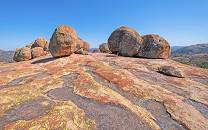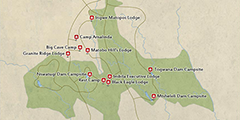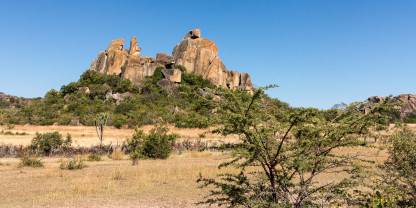Matobo National Park protects a breathtaking landscape of bald granite outcrops and gravity-defying balancing rocks. A scenic highlight is World’s View, a commanding granite whaleback topped by Cecil John Rhodes’ tomb. Often referred to as Matopos, the park hosts an abundance of prehistoric rock art, and while wildlife viewing is slow, it’s the best place in Zimbabwe to track rhinos.

-
Best Time To Go
- June to October (Middle to end of the Dry season)
-
High Season
- July to September (Matobo doesn't get too busy)
-
Size
- 445km² / 172mi²
-
Altitude
-
1,169-1,462m /3,835-4,797ft
 View Photos
View Photos
 View Photos
+23
Photos
View Photos
+23
Photos
 Open Map
Open Map
Pros & Cons
- Dramatic rock landscape
- Great birding destination, especially for raptors
- Excellent rock art
- Rhino tracking on foot
- Good park for self-drive visitors
- Easily visited as a day trip from the nearby city of Bulawayo
- Accommodation options for different budgets available
- Limited variety of safari animals (no elephant and lion)
- Limited road network
Wildlife
Matobo has no lion or elephant, but the secretive black rhino is present and white rhino can be tracked on foot with a high success rate. The hills of Matobo are textbook leopard territory and the park reputedly supports Zimbabwe’s densest concentration of this agile cat, but sightings are uncommon and generally fleeting. Another animal associated with the hilly terrain is the klipspringer, which is often found in pairs hopping from rock to rock.
More about Matobo’s wildlifeScenery
Two types of granite formations dominate the scenery. Huge, smooth, gray whaleback hills rise up from the plains. Even more dramatic are the balancing piles of angular-shaped rocks, which look like giant children’s toys carefully stacked on top of each other. This distinctive rocky landscape, together with the prehistoric rock art it protects, has led to the park being inscribed as a Unesco World Heritage Site.
Activities
The most popular activity is the scenic drive to Rhodes’ grave, which involves a short, steep climb from a car park. This is easily combined with white rhino tracking and/or a visit to see some rock art (Nswatugi Cave is the most impressive of the more accessible sites). Other activities include in Whovi Wilderness Area (home to both rhino species) and guided hikes to remote rock paintings.
Weather & Climate
During Matobo’s Dry season (April to October), sunny days are the norm, but early mornings and evenings are chilly. During the Wet season (November to March), heavy afternoon downpours interrupt the bright conditions.
More about the weather and climateBest Time To Visit
Matobo is best visited from June to October, during the middle and end of the Dry season. This coincides with the high season, but you’ll rarely be troubled by anything resembling a crowd here. You will, however, get to see slightly more wildlife at this time, with the animals gathering around the available water sources. The wetter months from November to April are favored by birders.
More about the best time to visit



